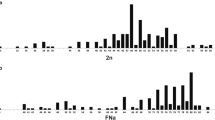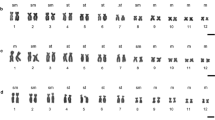Abstract
G-, C-, Q-banding and standard karyotypic analyses were used to study the chromosomal relationships of emydid turtles. Ten species of emydids were used (5 batagurines and 5 emydines) which samples all of the karyotypic variation known for the Emydidae. Data from a testudinid and a chelydrid are compared to the emydids. The karyotype of Mauremys and Sacalia is considered representative of the primitive karyotype for this group because of its widespread occurrence in the morphologically primitive Batagurinae and its similarity to that of some testudinids. The emydine karyotype is believed to have evolved from the primitive batagurine karyotype by the deletion of a heterochromatic macrochromosome. Siebenrockiella and Rhinoclemys are karyotypically derived batagurines.
Similar content being viewed by others
References
Bickham, J.W.: A cytosystematic study of turtles in the genera Clemmys, Mauremys and Sacalia. Herpetologica 31, 198–204 (1975)
Bickham, J. W.: A meiotic analysis of 4 species of turtles. Genetica (den Haag) (in press, 1976)
Bickham, J. W., Baker, R. J.: A karyological study of some neotropical turtles. Copeia (Wash.) (in press, 1976)
Bradshaw, W.N., Hsu, T.C.: Chromosomes of Peromyscus (Rodentia, Cricetidae) III. Polymorphism in Peromyscus maniculatus. Cytogenetics 11, 436–451 (1972)
Caspersson, T., Zech, L., Modest, E.J., Foley, G.E., Wagh, U., Simonsson, E.: Chemical differentiation with fluorescent alkylating agents in Vicia faba metaphase chromosomes. Exp. Cell Res. 58, 128–140 (1969)
Fredga, K., Mandahl, N.: Autosomal heterochromatin in some carnivores. Nobel Symp. 23, 104–117 (1973)
Grouchey, J. de, Turleau, C., Roubin, M., Colin, F.C.: Chromosomal evolution of man and the primates (Pan troglodytes, Gorilla gorilla, Pongo pygmaeus). Nobel Symp. 23, 124–131 (1973)
Hay, O.P.: The fossil turtles of North America. Carnegie Inst. Wash. Publ. 75, 1–568 (1908)
Levan, A., Fredga, K., Sandberg, A.A.: Nomenclature for centromeric position in chromosomes. Hereditas (Lond.) 52, 201–220 (1964)
Mascarello, J.T., Stock, A.D., Pathak, S.: Conservatism in the arrangement of genetic material in rodents. J. Mammal. 55, 695–704 (1974)
McDowell, S.B.: Partition of the genus Clemmys and related problems in the taxonomy of the aquatic Testudinidae. Proc. Zool. Soc. London 143, 239–279 (1964)
Moorhead, P.S., Nowell, P.G., Mellman, W.J., Batipps, D.M., Hungerford, D.A.: Chromosome preparations of leukocytes cultured from human peripheral blood. Exp. Cell Res. 20, 613–616 (1960)
Pathak, S., Hsu, T.C., Arrighi, F.E.: Chromosomes of Peromyscus (Rodentia, Cricetidae). IV. The role of heterochromatin in karyotypic evolution. Cytogenet. Cell Genet. 12, 315–326 (1973a)
Pathak, S., Hsu, T.C., Shirley, L.: Chromosome homology in the climbing rats, genus Tylomys (Rodentia: Cricetidae). Chromosoma (Berl.) 42, 215–228 (1973b)
Patton, J.L.: Chromosome studies of certain pocket mice, genus Perognathus. J. Mammal. 48, 27–37 (1967)
Pearson, P.: The uniqueness of the human karyotype. Nobel Symp. 23, 145–151 (1973)
Sampaio, M.M., Barros, R.M., Ayres, M., Cunha, O.R.: A karyological study of two species of tortoises from the Amazon region of Brazil. Cytologia (Tokyo) 36, 199–204 (1971)
Seabright, M.: A rapid banding technique for human chromosomes. Lancet 1971 II, 971–972
Stock, A.D.: Karyological relationships in turtles (Reptilia: Chelonia). Canad. J. Genet. Cytol. 14, 859–868 (1972)
Stock, A.D., Arrighi, F.E., Stefos, K.: Chromosome homology in birds: banding patterns of the chromosomes of the domestic chicken, ring-necked dove, and domestic pigeon. Cytogenet. Cell Genet. 13, 410–418 (1974)
Stock, A.D., Mengden, G.A.: Chromosome banding pattern conservatism in birds and nonhomology of chromosome banding patterns between birds, turtles, snakes and amphibians. Chromosoma (Berl.) 50, 69–77 (1975)
Takagi, N., Sasaki, M.: A phylogenetic study of bird karyotypes. Chromosoma (Berl.) 46, 91–120 (1974)
Turleau, E., Grouchey, J. de, Klein, M.: Phylogénie chromosomique de l'homme et des primates hominiens (Pan troglodytes, Gorilla gorilla et Pongo pygmaeus), essai de reconstitution du caryotype de l'ancêtre commun. Ann. Génét. 15, 225–240 (1972)
Yosida, T.H., Sagai, T.: Similarity of Giemsa banding patterns of chromosomes in several species of the genus Rattus. Chromosoma (Berl.) 41, 93–101 (1973)
Zech, L.: Florescence banding techniques. Nobel Symp. 23, 28–31 (1973)
Author information
Authors and Affiliations
Rights and permissions
About this article
Cite this article
Bickham, J.W., Baker, R.J. Chromosome homology and evolution of emydid turtles. Chromosoma 54, 201–219 (1976). https://doi.org/10.1007/BF00293451
Received:
Accepted:
Issue Date:
DOI: https://doi.org/10.1007/BF00293451




